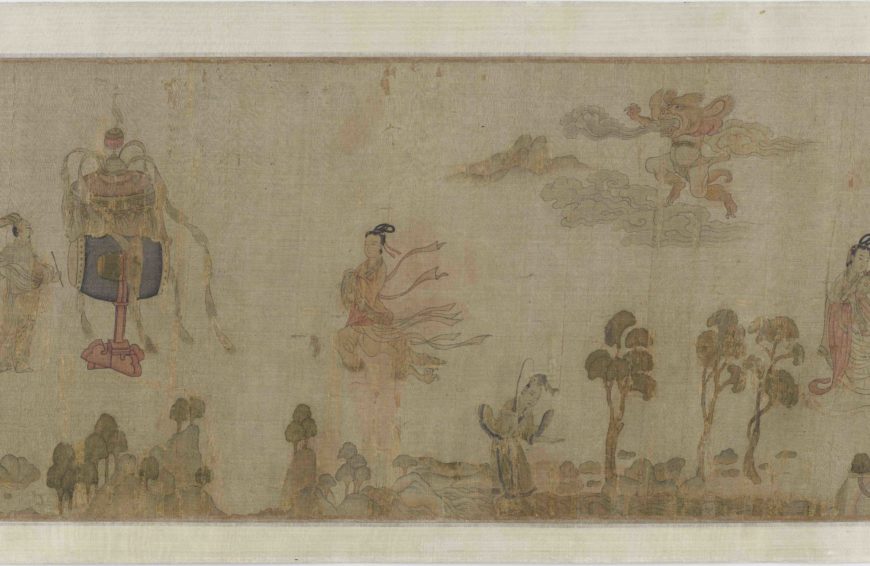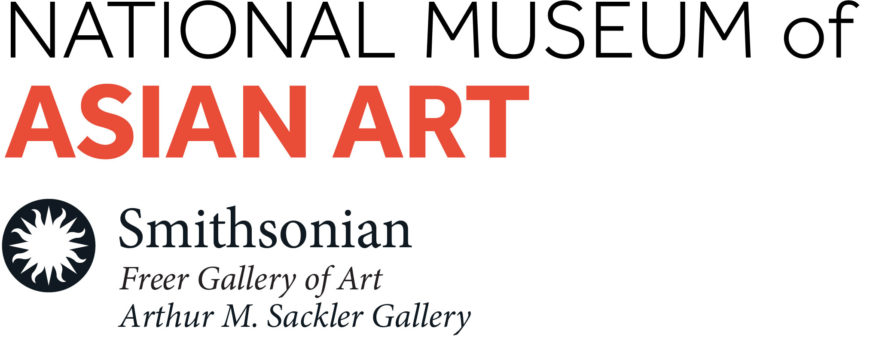
A Song dynasty copy of a work traditionally attributed to Gu Kaizhi (傳)顧愷之 (c. 344–c. 406), colophon by Dong Qichang 董其昌 (1555–1636), detail of Nymph of the Luo River, Southern Song dynasty, mid-12th to mid-13th century, ink and color on silk, China, 24.2 x 310.9 cm (Freer Gallery of Art, Smithsonian Institution, Washington, DC: Gift of Charles Lang Freer, F1914.53)
This handscroll illustrates a long poem written in 222 C.E. by the poet and prince Cao Zhi (192–232). The poem describes the prince’s imaginary romantic encounter with the nymph, or goddess, of the Luo River in central China. They fall in love but eventually part with one another. The prince and the goddess are repeatedly depicted in different sections of the painting, recognizable by the same headdress and hair style. Each section tells a portion of the story. The painting was done in light colors. The figures, trees, clouds, and mountains were first defined with outlines and then filled in with color washes. The figures are beautifully drawn. Their garments, especially the ribbons, were painted so lightly and flowing that one can almost feel the breeze. The landscape, including the trees, clouds, and mountains, seems simplified. The landscape features appear disproportionately smaller than the figures and seem to serve as mere stage sets for various plots.

A Song dynasty copy of a work traditionally attributed to Gu Kaizhi (傳)顧愷之 (c. 344–c. 406), colophon by Dong Qichang 董其昌 (1555–1636), detail of Nymph of the Luo River, Southern Song dynasty, mid-12th to mid-13th century, ink and color on silk, China, 24.2 x 310.9 cm (Freer Gallery of Art, Smithsonian Institution, Washington, DC: Gift of Charles Lang Freer, F1914.53)
Only about half of the work’s original length survived, but it is still an important Southern Song (1127–1279) copy of an early composition. We can recognize from the painting the emergence of Chinese landscape tradition. Streams were drawn with care and delicacy. Most importantly, simplistic as they may seem, each landscape element works together to form a coherent physical environment. Beyond the individual artistic elements, the painting is a perfect example of Chinese narrative illustration. Different sections of a story appear in a single composition. The same characters reappear several times throughout the painting. Handscroll is the perfect format for such illustration. Read from right to left, each section that is unrolled reveals another part of the story.
The scroll’s first colophon is by the great Ming scholar and official Dong Qichang (1555–1636), who admires and authenticates the painting. It also includes colophons and collector seals from other important scholars and connoisseurs from different times. From these records, we can tell a wonderful story about the painting’s life.
 This resource was developed for Teaching China with the Smithsonian, made possible by the generous support of the Freeman Foundation
This resource was developed for Teaching China with the Smithsonian, made possible by the generous support of the Freeman Foundation
For the classroom
Discussion questions:
- What are the visual clues that indicate this story is a myth?
- What is the advantage of telling a story in the format of a handscroll versus a bound book?
- Can you recall any other myths of a failed romance between a human and a god or goddess?

